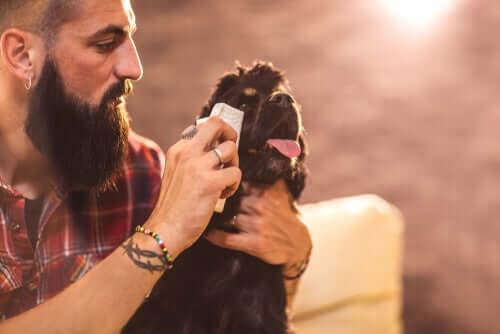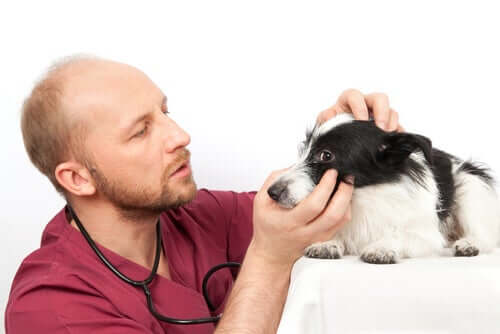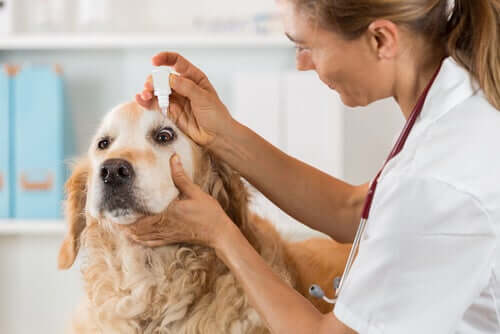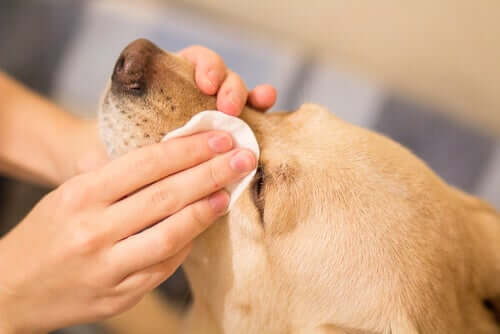Learn How to Clean Your Dog's Eyes

If you are especially worried about how to clean your dog’s eyes, it’s probably because you’ve seen a lot of secretions in or around its eyes. The first thing you should do is make sure that a medical problem is not what’s making their eyes crusty.
Regardless of whatever is happening with your dog’s eyes, they must always stay clean. Some dogs tend to have crustier eyes than others. These, especially, are the ones to pay attention to. However, that isn’t to say you should neglect dogs whose eyes don’t seem so dirty.
In any case, it’s true that many dogs simply have excessive ocular discharge. However, it can also be a sign of something more serious. If, along with the discharge, you notice redness, a lot of cloudiness and/or swelling, you should take your dog to the vet. Especially if there’s bleeding, as this may be a sign of an eye infection or another serious condition.

Key steps to clean your dog’s eyes
If there’s no medical problem, you can clean your dog’s eyes at home without any problems. To remove any general griminess around his eyes, you must gently wipe along the edge of his eye with clean gauze soaked in saline.
You can use eye wipes made specifically for dogs, but they’re generally not necessary. In any case, it’s important to clean around the entire eye but never to directly touch the surface of the eye, i.e. the eyeball itself.
If there’s dirt or debris directly inside the dog’s eye, you’ll need to rinse it with an eye rinse. There are specific solutions for dogs, but you can also use physiological saline.

To wash your dog’s eyes, put the eye rinse or saline bottle near the eye, but never inside it. Then squeeze the container gently so that the liquid comes out. You should tilt the container downwards. This will make it easier for the liquid to roll out and drag the dirt out of its eye.
Since this can be stressful for the dogs, be sure to keep them calm and give them a reward when it’s over. If it’s difficult for you to perform the task of cleaning their eyes, then you can go to a dog groomer or even to the veterinarian to take care of it.
The best time to wash your dog’s face and eyes is at bath time. However, it’s not always possible to wait. Cleaning its eyes is a fairly simple process. Also, there’s no set recommendation of how often it should be done. Just keep an eye on your dog, and clean its eyes whenever necessary.

Tear spots on light fur
If your dog’s coat is white or very light-colored, the animal may be susceptible to tear stains. These spots occur when the tears in your dog’s eyes build up and color the fur underneath them brown or reddish.
Breeds like Poodles, Cocker Spaniels or Shih Tzus are susceptible to having excessively teary eyes. This is because their thick hair often irritates them. It’s important to resolve these issues as soon as possible, as they can become a breeding ground for bacteria if they remain wet for too long.
If routinely cleaning their eyes with a wet wipe doesn’t remove the stains, then there are products specially designed for this condition. You can also make a homemade cleaner to remove tear stains. Mix equal parts of cornstarch and hydrogen peroxide. Then, apply the solution to the dog’s skin without coming into direct contact with his eyes.
If you don’t like that solution, mix boric acid and cornstarch. Again, avoid letting it come into contact with the dog’s eyes. Let the mixture dry for a couple of hours and then rinse it clean with warm water.
Prevention is the best way to avoid these tear stains, and the risk they create. There are many products on the market to keep the tear stains from forming in the future. Consult your veterinarian about specific products according to your dog’s needs.